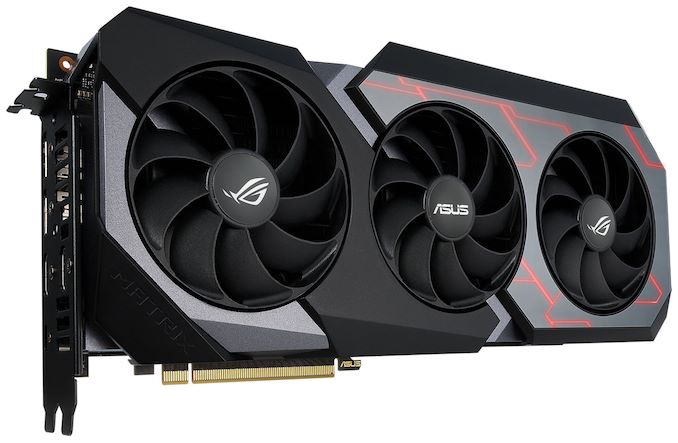CES 2019: ASUS Unveils the ROG Matrix RTX 2080 Ti With Hybrid Cooling
by Gavin Bonshor on January 8, 2019 2:00 PM EST- Posted in
- GPUs
- Asus
- GeForce
- ROG
- Trade Shows
- NVIDIA
- CES 2019
- RTX 2070
- Matrix
- RTX 2080 Ti

ASUS has announced a brand new Turing based model to their range with the ROG Matrix RTX 2080 Ti graphics card. The Matrix branding is synonymous with premium and the RTX 2080 Ti feature set looks nothing short of feature packed.
What makes the ROG Matrix RTX 2080 Ti stand out from the crowd is the use of ASUS's new Infinity Loop cooling hybrid cooling solution. Infinity Loop integrates a closed loop cooling system within the cooling shroud housing a pump, radiator and tubing within a triple fan designed cooler. Due to constraints that are associated with cramming numerous components underneath what looks like a seemingly regular GPU cooler, the ROG Matrix RTX 2080 Ti takes up a total of three PCIe slots. ASUS claims the Infinity Loop cooling solution beats rival vendors with 120mm hybrid cooling designs and even competes with models that feature 240mm radiators.
Included on the rear of the PCB is a metallic carbon fibre styled backplate with swathes of RGB LED lighting throughout the cooler which is supported by the ASUS AURA Sync software. The Infinity Loop cooler has three Axial-Tech fans and also features 0db technology. This means when the card is operating below 55 degrees Celsius, the Matrix cooler operates passively for optimal acoustic performance while light gaming and performing general tasks such as web browsing.
In line with a top of the range product, ASUS has stated that each ROG Strix RTX 2080 Ti PCB used goes through an aggressive binning process to ensure each Matrix card adheres to the high boost core clock speed of 1815 MHz out of the box. This is an 11% overclock over the standard RTX 2080 Ti Founders Edition which has a boost core clock of 1635 MHz out of the box. The GDDR6 memory of the ROG Matrix RTX 2080 Ti is also overclocked to 1850 MHz while the Founders Edition model has a memory clock of 1750 MHz. This makes the ROG Matrix one of the fastest out of the box RTX 2080 Ti models on the market.
The rear panel of the ROG Matrix RTX 2080 Ti deviates from the standard RTX 2080 Ti Founders Edition slightly with two DisplayPort 1.4, two HDMI 2.0b and a USB Type-C VirtualLink video output. Power wise the Matrix RTX 2080 Ti uses two 8-pin PCIe power inputs and has a rated TDP of 300 W; 40 W more than the RTX 2080 Ti Founder Edition model which has a 260 W rating.
ASUS hasn't specified a price as of yet for the ROG Matrix RTX 2080 Ti but given utilization of the exclusive Infinity Loop cooling technology, it's not expected to be cheap. The ROG Matrix RTX 2080 Ti is set to make its entry into the market later this month.
Source: ASUS












21 Comments
View All Comments
madwolfa - Tuesday, January 8, 2019 - link
I own a EVGA 1080Ti Hybrid and one of the main advantages is that it effectively expels all the hot air out of the case. What's the point of ASUS solution? Just a slightly more efficient open-air alternative?Hxx - Tuesday, January 8, 2019 - link
this may cool better as there are more fans and more surface area (240 mm rad size). But to your point its just a glorified cooler as the vrms are still air cooled and at what point u are just better off building a custom water loop. A few hundred dollar premium on this card will get u a real waterblock and an actual 240mm rad and probably cash to spare to put towards other components in your loop.maedhrosfeanor - Thursday, January 10, 2019 - link
There is not more surface area, look at the tear down, its just a 120 (maybe slightly larger) on half the card. And it blows heat to the surface of the card.Simon_Says - Wednesday, January 9, 2019 - link
Maybe it's for some theoretical bonkers mini-ITX case with a separated, triple-high GPU chamber.madwolfa - Wednesday, January 9, 2019 - link
Mini-ITX would still benefit the most from either a blower or external rad approach.Simon_Says - Wednesday, January 9, 2019 - link
Not if it's something like akin to a Silverstone RVZ03.As I said. Bonkers.
PeachNCream - Tuesday, January 8, 2019 - link
I think this card makes the case for reinforced PCI-E slots or justifies bringing back a bracket at the front of the case akin to something that used to support full-length ISA expansion cards. Ultimately, this is just an attempt at product differentiation in a market filled with RTX 2080 Ti GPUs at the top that makes all top-tier video cards essentially identical products with different brand logos stamped on them.koaschten - Wednesday, January 9, 2019 - link
Yeah or case with 90° conversion kits to mount GFX cards vertically standing via a riser card/cable.LauRoman - Tuesday, January 8, 2019 - link
Linus from LTT, already showed the radiator and pump, this morning-ish. I came here hoping to see more, like the block and circuit flow (he suggested there may be two)...Instead we just get press pics...
Simon_Says - Wednesday, January 9, 2019 - link
GamersNexus did a tear down of this card. v=9OzolCFqb4k